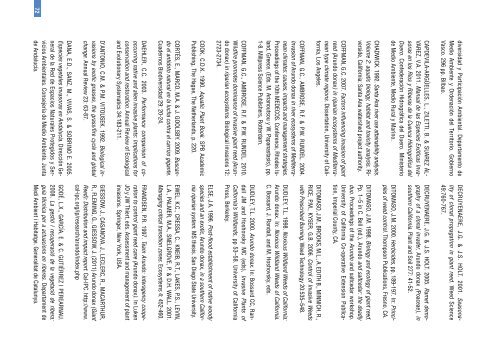Bases_para_el_manejo_y_control_de_Arundo_donax_tcm7-326547
Bases_para_el_manejo_y_control_de_Arundo_donax_tcm7-326547
Bases_para_el_manejo_y_control_de_Arundo_donax_tcm7-326547
You also want an ePaper? Increase the reach of your titles
YUMPU automatically turns print PDFs into web optimized ePapers that Google loves.
diversidad y Participación Ambiental. Departamento <strong>de</strong>Medio Ambiente y Or<strong>de</strong>nación d<strong>el</strong> Territorio. GobiernoVasco. 296 pp. Bilbao.DECRUYENAERE, J.G. & J.S. HOLT. 2001. Seasonalityof clonal propagation in giant reed. Weed Science49:760-767.CAPDEVILA-ARGÜELLES, L., ZILETTI, B. & SUAREZ ÁL-VAREZ, V.A. 2011. Manual <strong>de</strong> las Especies Exóticas Invasorasen los Ríos y Riberas <strong>de</strong> la Cuenca Hidrográfica d<strong>el</strong>Duero. Confe<strong>de</strong>ración Hidrográfica d<strong>el</strong> Duero. Ministerio<strong>de</strong> Medio Ambiente, Medio Rural y Marino.CHADWICK. 1992. Santa Ana river use attainability analysis.Volume 2: aquatic biology, habitat and toxicity analysis. Riversi<strong>de</strong>,California: Santa Ana watershed project authority.COFFMAN, G.C. 2007. Factors influencing invasion of giantreed (<strong>Arundo</strong> <strong>donax</strong>) in riparian ecosystems of Mediterraneantype climate regions. Dissertation, University of California,Los Ang<strong>el</strong>es.COFFMAN, G.C., AMBROSE, R.F. & P.W. RUNDEL. 2004.Invasion of <strong>Arundo</strong> <strong>donax</strong> in river ecosystems of Mediterraneanclimates: causes, impacts and management strategies.Proceedings of the 10th MEDECOS. Conference, Rho<strong>de</strong>s Island,Greece. (Eds. M. Arianoutsou y W. Papanastasis), pp.1-8. Millpress Science Publishers, Rotterdam.COFFMAN, G.C., AMBROSE, R.F. & P.W. RUNDEL. 2010.Wildfire promotes dominance of invasive giant reed (<strong>Arundo</strong><strong>donax</strong>) in riparian ecosystems. Biological invasions 12:2723-2734.COOK, C.D.K. 1990. Aquatic Plant Book. SPB Aca<strong>de</strong>micPublishing, The Hague, The Netherlands, p. 220.DECRUYENAERE, J.G. & J.S. HOLT. 2005. Ramet <strong>de</strong>mographyof a clonal inva<strong>de</strong>r, <strong>Arundo</strong> <strong>donax</strong> (Poaceae), insouthern California. Plant and Soil 277: 41-52.DiTOMASO, J.M. 2000. Herbici<strong>de</strong>s, pp. 189-197. In: Principlesof weed <strong>control</strong>. Thompson Publications, Fresno, CA.DiTOMASO, J.M. 1998. Biology and ecology of giant reed.Pp. 1–5 in C. B<strong>el</strong>l (ed.), <strong>Arundo</strong> and saltcedar: the <strong>de</strong>adlyduo. Proceedings of the <strong>Arundo</strong> and saltcedar workshop.University of California Co-operative Extension Publication,Imperial County, CA.DiTOMASO, J.M., BROOKS, M.L., A. EDITH B., MINNICH, R.,RICE, P.M., KYSER, G.B. 2006. Control of Invasive Weedswith Prescribed Burning. Weed Technology 20:535–548.DUDLEY, T.L. 1998. Noxious Wildland Weeds of California:<strong>Arundo</strong> <strong>donax</strong>. In: Noxious Wildland Weeds of California.C. Bossard, J. Randall, and M. Hoshovsky, eds.DUDLEY, T.L. 2000. <strong>Arundo</strong> <strong>donax</strong>. In: Bossard CC, RandallJM and Hoshovsky MC (eds), Invasive Plants ofCalfornia’s Wildlands, pp 53–58. University of CaliforniaPress, Berk<strong>el</strong>ey.ELSE, J.A. 1996. Post-flood establishment of native woodyspecies and an exotic, <strong>Arundo</strong> <strong>donax</strong>, in a southern Californiariparian system. MS thesis. San Diego State University.CORTÉS, E., MARCO, M.A. & J. GOOLSBY. 2009. Buscando<strong>el</strong> antídoto natural en la lucha contra <strong>el</strong> carrizo gigante.Cua<strong>de</strong>rnos Biodiversidad 29: 20-24.EWEL, K.C., CRESSA, C., KNEIB, R.T., LAKES, P.S., LEVIN,L.A., PALMER, M.A., SNELGROVE, P. & D.H. WALL. 2001.Managing critical transition zones. Ecosystems 4: 452-460.DAEHLER, C.C. 2003. Performance comparison of cooccurringnative and alien invasive plants: Implications forconservation and restoration. Annual Review of Ecologicaland Evolutionary Systematics 34:183-211.FRANDSEN, P.R. 1997. Team <strong>Arundo</strong>: interagency cooperationto <strong>control</strong> giant reed cane (<strong>Arundo</strong> <strong>donax</strong>). In LukenJO y JW Thiert, eds. Assessment and management of plantinvasions. Springer, New York, USA.72D’ANTONIO, C.M. & P.M. VITOUSEK. 1992. Biological invasionsby exotic grasses, the grass/fire cycle and globalchange. Annual Review 23: 63-87.DANA, E.D., SANZ, M., VIVAS, S. & SOBRINO E. 2005.Especies vegetales invasoras en Andalucía. Dirección General<strong>de</strong> la Red <strong>de</strong> Espacios Naturales Protegidos y ServiciosAmbientales. Consejería <strong>de</strong> Medio Ambiente. Junta<strong>de</strong> Andalucía.GIESSOW, J., CASANOVA, J., LECLERC, R., MACARTHUR,R., FLEMING, G., GIESSOW, J. (2011) <strong>Arundo</strong> <strong>donax</strong> (GiantReed): Distribution and impact report. Cal-IPC. http://www.cal-ipc.org/ip/research/arundo/in<strong>de</strong>x.phpGODÉ, L.X., GARCÍA, E. & C. GUTIÉRREZ I PEREARNAU.2008. La gestió i recuperació <strong>de</strong> la vegetació <strong>de</strong> ribera:guia tècnica per a actuacions en riberes. Departament <strong>de</strong>Medi Ambient i Habitatge. Generalitat <strong>de</strong> Catalunya.


